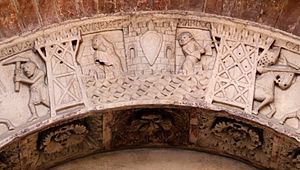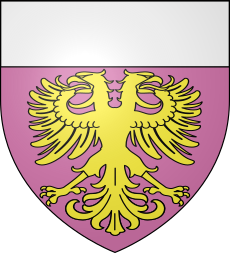Mordred facts for kids
Quick facts for kids Mordred |
|
|---|---|
| Matter of Britain character | |
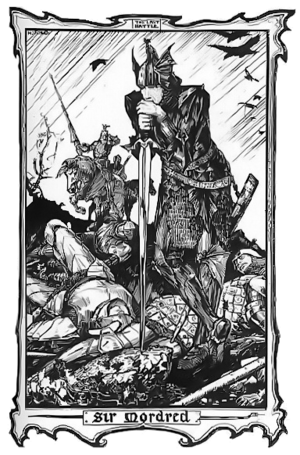
Sir Mordred by H. J. Ford (1902)
|
|
| First appearance | Annales Cambriae (Medraut) Historia Regum Britanniae (Mo[r]dred) |
| Information | |
| Occupation | Usurper King of the Britons (a prince of Orkney and a knight of the Round Table in later tradition) |
| Title | Sir, Prince, King |
| Family | Parents: Arthur or Lot, Anna / Morgause Brothers: Gawain; often also Agravain, Gaheris and Gareth |
| Spouse(s) | Either Guinevere, Gwenhwyfach or Cwyllog |
| Children | Sometimes two sons including Melehan |
| Relatives | King Arthur's family |
| Nationality | Briton |
| Home | Lothian / Orkney, Camelot |
Mordred (also spelled Modred) is a famous character from the legends of King Arthur. He is often known as Arthur's nephew or son. Mordred plays a very important role in the story of Arthur's downfall.
In early Welsh stories, Mordred (called Medraut) was mentioned in connection with the Battle of Camlann. His role in these early tales is not always clear. Later, in French stories and books like Le Morte d'Arthur, Mordred becomes a knight of the Round Table. However, he eventually turns against King Arthur, leading to a big conflict.
Contents
What's in a Name?
The name Mordred comes from the Latin word Modredus. This word was used by Geoffrey of Monmouth in his book Historia Regum Britanniae. The name might come from an older Welsh word, Medraut. It could also be linked to Latin words meaning "moderate" or even "death."
Early Stories of Mordred
The very first time Mordred is mentioned is in a Welsh record called Annales Cambriae. This record talks about the year 537 and links his name to the Battle of Camlann.
However, this old record does not say if Mordred fought against Arthur. It also doesn't say if he killed Arthur or was killed by him.
An old stone carving from Italy, called the Modena Archivolt, might show Mordred. It seems to show a scene where Guinevere is taken away. Some think the figure named Mardoc on this carving could be Mordred.
Mordred in Later Legends
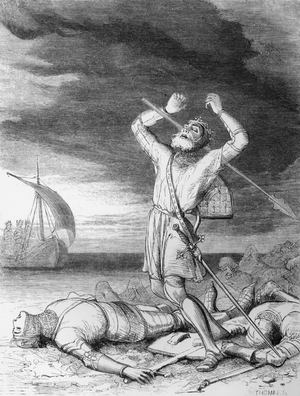
In Geoffrey of Monmouth's book Historia Regum Britanniae (written around 1136), Modredus (Mordred) is shown as Arthur's nephew and a traitor. Geoffrey's story says that Arthur leaves Modredus in charge of his kingdom. Arthur then goes to fight a war in Rome.
While Arthur is away, Modredus crowns himself King of the Britons. When Arthur returns, they fight a huge battle at Camlann. Modredus is killed in this battle. Arthur is badly hurt and is taken to Avalon to be healed.
Mordred's Life in Romances
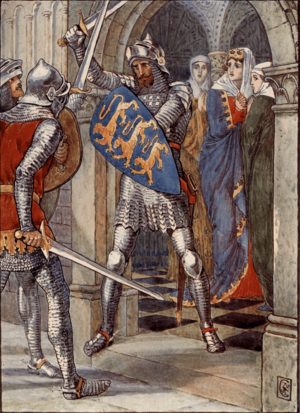
In later stories, especially French romances from the 13th century, Mordred's life before the war with Arthur is explored more. In some versions, a prophecy warns Arthur that a newborn child will cause his downfall. To prevent this, Arthur tries to get rid of all babies born on May Day.
However, Mordred survives this event. He is found and raised by a fisherman and his wife. Later, he reunites with his mother and becomes a knight. He joins King Arthur's famous Knights of the Round Table.
In some tales, Mordred becomes a friend and student of the great knight Lancelot. Lancelot even saves Mordred's life many times. But then, an old monk tells them a prophecy. This prophecy reveals Mordred's true parents and predicts his role in the kingdom's ruin. Mordred, angry, kills the monk.
Eventually, Mordred takes over Arthur's kingdom. This happens while Arthur is away fighting a war, either against Lancelot or against the Romans. In some stories, Mordred tricks people with a fake letter from Arthur.
Many people in Britain support Mordred. They are ready to fight for him when Arthur returns. Arthur's army is attacked when they land at Dover. In this battle, Arthur's loyal knight Sir Gawain is badly hurt. After more fights, both sides agree to a final battle.
The Death of Mordred
The final battle takes place at Camlann. In most versions of the legend, Mordred fights very bravely. He commands thousands of men who are loyal to him.

"Then the king ran towards Sir Mordred, crying, 'Traitor, now is thy death day come.'"
In the most popular telling, Arthur and Mordred meet in a final duel. They both strike each other down. Mordred is killed, and Arthur is gravely wounded. This tragic duel marks the end of Arthur's reign.
There are a few other stories about Mordred's death. Some say Lancelot kills him. Others say Mordred survives the battle but is later captured and buried alive with Guinevere. However, the duel with Arthur at Camlann is the most well-known version.
Mordred's Family
The stories about Mordred's family ties to Arthur are different. In early Welsh texts, Mordred is always Arthur's nephew, not his son. He is sometimes said to be Arthur's foster son.
In stories from Geoffrey of Monmouth, Mordred is the son of Arthur's sister or half-sister, Morgause (also called Anna or Gwyar), and her husband, King Lot. King Lot ruled either Lothian or Orkney. Today, Mordred is most famous for being King Arthur's own son, though an illegitimate one.
Mordred's Children
Since Geoffrey's stories, Mordred is often said to have two sons. Their names are usually not given, and their mother is also not named.
Mordred in Modern Stories
Mordred appears a lot in modern books, movies, TV shows, and comics about King Arthur. He has been played by many actors, including Roddy McDowall in the musical Camelot.
In almost every story where Mordred appears, his name means treason or betrayal. He is a key villain in the Arthurian legends.
Images for kids
-
Sir Mordred by H. J. Ford (1902)
-
The Death of Arthur, George Housman Thomas's illustration for Thomas Malory's Le Morte d'Arthur in an 1862 edition by James Thomas Knowles
-
Lancelot fighting Mordred and Agravain in Guinevere's chambers, Walter Crane's illustration for Henry Gilbert's King Arthur's Knights (1911)
-
N. C. Wyeth illustration for Sidney Lanier's The Boy's King Arthur (1922)
"Then the king ran towards Sir Mordred, crying, 'Traitor, now is thy death day come.'" -
Roddy McDowall as Mordred in the Broadway musical Camelot (1960)
See also
 In Spanish: Mordred para niños
In Spanish: Mordred para niños
- Illegitimacy in fiction


